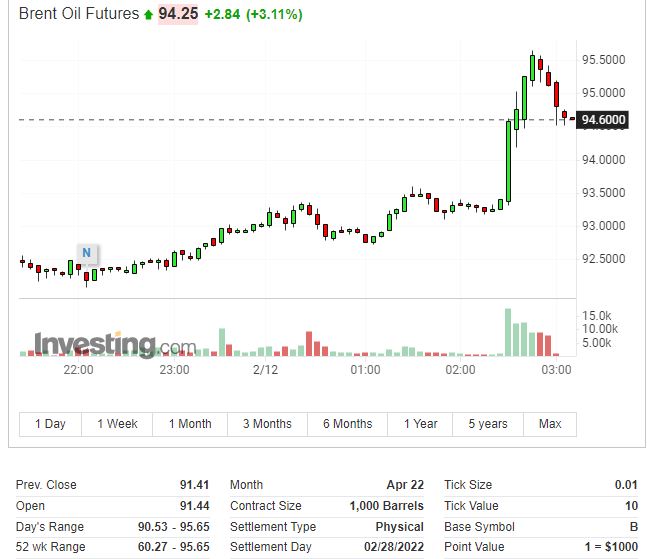U.S. stocks fell more widely, with the Dow falling 500 points at one point, the S&P down 1.8%, the NASDAQ down 2.6%, international oil prices rising more than $4 during the day, and gold prices rising more than 1%.
Tensions between Russia and Ukraine continued to rise, with U.S. President Joe Biden warning Americans in Ukraine to leave immediately, saying that Ukraine "could soon become crazy," signs of escalation were "disturbing" and that "when the United States and Russia begin to exchange fire, it will be a world war." According to CCTV News, the British government advises its citizens to leave Ukraine as soon as possible. The sell-off of risky assets intensified, oil prices refreshed the highs of nearly eight years, and safe-haven assets rose sharply.
Inflation concerns have worsened Americans' perception of their personal finances, with the University of Michigan's February consumer confidence index falling from 67.2 to 61.7 in February, below expectations and a decade-low since October 2011, with one-year inflation expectations rising to 5 percent to its highest level since 2008.
Goldman Sachs quickly raised its forecast after the inflation explosion, and together with the Bank of America, it expects the Fed to raise interest rates as high as 7 times this year. The Fed's "Valentine's Day meeting" agenda has also sparked speculation about rate hikes, and some people expect the Fed to raise interest rates in particular at the end of February.
But the Fed presidents of Atlanta, Richmond and San Francisco all opposed a one-time 50 basis point hike in March yesterday, suggesting that the rate hike would be restrained. Some analysts said that the Fed may not be in a hurry to raise interest rates before March, and the probability of a 50 basis point rate hike in March is not large, because an early emergency rate hike will unnecessarily send panic signals to the market, and the impact caused by the impact cannot achieve Powell's "economic soft landing" goal.
Futures markets have repriced the odds of a rate hike, with the probability of a 50 basis point hike in March falling to 66% from nearly 100% yesterday. The U.S. Federal Funds Rate Futures February contract rebounded to 99.90, representing a 0.10% drop in traders' probability of an "emergency" rate hike by the Fed between its two regular meetings, and the contract fell to 99.845 at one point yesterday, meaning that the probability of an "urgent" rate hike was as high as 30%.
Meanwhile, ECB President Christine Lagarde, who unexpectedly sent hawkish signals last week, once again weighed on market hawkish expectations, warning on Friday that the ECB's move too quickly or would stifle the economic recovery and would raise interest rates "gradually and gradually", still expecting inflation to fall later this year. Philip Lane, the ecbbank's chief economist, also said that inflation could ease on its own without taking harsher action, triggering a decline in the euro.
Before the close of international oil prices came the news of the deterioration of the situation in Russia and Ukraine, the US oil WTI quickly stood at $94, the intraday increase expanded from 2% to the highest rise of $4.77 or 5.3%, the daily high of $94.65 hit the highest since 2014. At one point, the cloth oil rose above $95, the highest intraday rise of $4.24 or 4.6%, and the daily high of $95.65 also refreshed the highest since 2014.
Before the news of the deterioration of the situation in Russia and Ukraine, oil prices were supposed to usher in a one-week decline after seven consecutive weeks of gains, but the short-term surge before the close made it turn up overall this week, and on Friday (February 4), WTI March crude oil futures closed up $2.04, or 2.26%, at $92.31 / barrel. Brent's April crude futures closed up $2.16, or 2.36 percent, at $93.27 a barrel.

Also contributing to the increase in oil prices is the IEA's forecast that insufficient supply of OPEC+ could push oil prices to their highest levels since 2014, with the gap between OPEC+ production and actual deliveries likely to be as high as 1 billion barrels by the end of the year, while OECD crude inventories fell to a seven-year low. OPEC's latest monthly report confirmed that January production increased by only 64,000 barrels per day instead of the planned 250,000 barrels, and it is feared that world oil demand may rise more sharply this year in the context of a strong economic recovery in the post-epidemic era.
However, the prospect of aggressive interest rate hikes by the Federal Reserve and plans to restart nuclear negotiations between the United States and Iran have limited the space for oil prices to rise further.
Warren Patterson, head of commodities research at ING, said market expectations that the Fed's aggressive interest rate hikes to combat inflation were putting pressure on oil and the broader commodity market to some extent. Iran is expected to supply an additional 1.3 million barrels per day of oil this year if the Iranian nuclear talks are successful, and officials on both sides have hinted that a deal may be reached, further increasing the likelihood of lifting sanctions on Iran.
(Continuous update)
This article is from Wall Street Insights, welcome to download the APP to see more